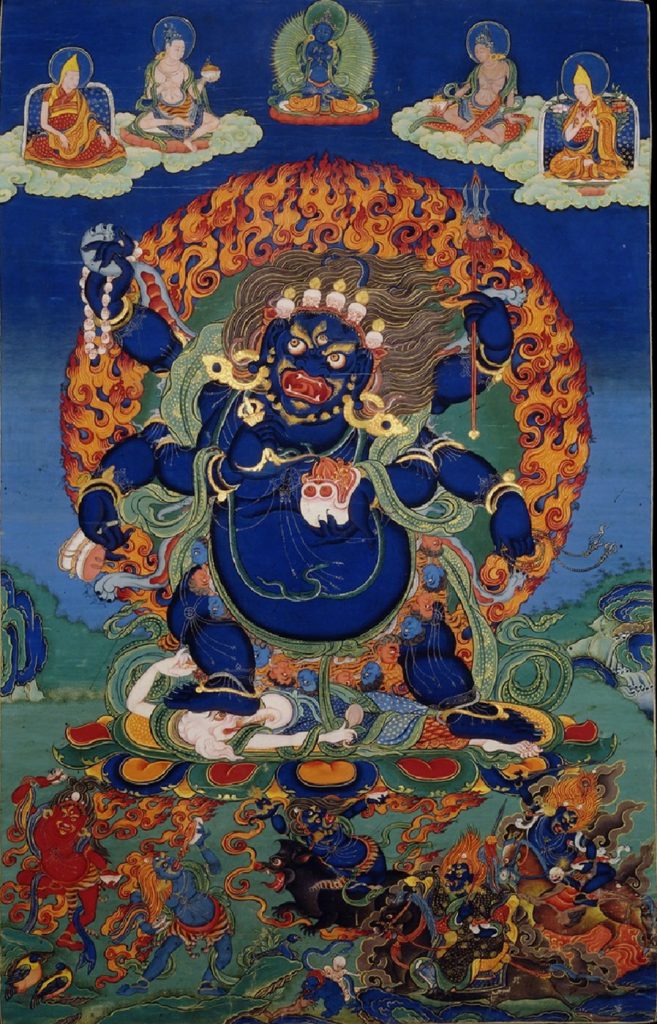This is Mahakala. “Maha” means great, and “kala” means black, but we can see that this black figure is actually dark blue. Completely black figures lose contrast and lack detail. This is why paintings were developed in which the background of the canvas is painted black and then the figures are outlined in gold or ochre. We see this same device used with comic-book characters like Batman, whose suit was originally black but was changed to blue to show detail.
Mahakala is not one individual but rather a class of deities. This one, with one face and six arms, is a wrathful form of Avalokiteshvara, bodhisattva of compassion, and is very popular in the Gelugpa lineage. We see two yellow-hat Gelugpa lamas at the top of the image, with the great master Tsongkhapa at the top right and Vajradhara, the primordial Buddha, at the top center. Like many deities in tantric Buddhism, Mahakala figures are borrowings from Indian culture, such as Shaivism or Vaishnavism, and many are local deities. The Mahakala we see here comes from what is conventionally called the Eight-Chapter Mahakala Tantra, and this depiction was popularized in the 12th century.
Mahakala’s wrathful appearance refers not to aggression or anger but to intensity.
In Himalayan art, we have eleven standardized appearances for deities. Among the most common are: peaceful appearance, semi-peaceful/wrathful, and animal-faced, in which the deity might have the face of an elephant or a lion or a Garuda bird. Mahakala’s wrathful appearance refers not to aggression or anger but to intensity. Think of a mother whose child suddenly darts into traffic or a crowd. The mother, who is otherwise peaceful or gentle, looks fierce and ready to take immediate action to protect her child.
Wrathful deities like Mahakala are referred to as raksha, meaning “protection.” Rakshas are short, squat, fat-bellied, ugly, carnivorous beings, very much like Orcs in Lord of the Rings. In Buddhism, we consider rakshas a sort of demon, and certainly from a Western point of view, they have a demonic appearance. From an Indian cultural point of view, they’re these wrathful, horrible things you don’t want to meet at night walking home.
Mahakala wears the typical ornaments of a wrathful deity. He sports severed heads around his waist, and the artist had some fun with these, as you can see from the expressions on the faces. He also has gold bangles and ornaments, which are not typical and were added by the artist to beautify him, perhaps to please a patron. The six arms generally represent the six perfections, and his wrathful crown of five skulls represents the five skandhas and the five wisdom Buddhas.
The eight snakes he wears represent the eight great nagas. If they’re not happy, they can cause disease, poverty, drought, and famine. So this shows Mahakala has control over them.
Mahakala is holding a trident, a symbol of Shiva, but Buddhist artists portray it more as a three-pronged vajra. In his lower left hand, he’s holding a lasso. It’s not a noose, it’s more like a bola. You can throw it to catch an obstacle and drag it closer, then subdue it with the trident.
In his upper right hand is a mala of dried skulls. They’re very small and are not meant to depict real skulls. They’re just symbolic. In his lower right hand, Mahakala has a double-sided drum, the damaru. And then, in his two main hands, which are over his heart, he holds a curved knife—a flaying knife for skinning—in one and in the other, a skull cup. The artist has embellished this so that it’s more than a skull cup, it’s an entire skull, and it contains a heart with blood pouring out of it. The blood typically represents the four Maras, the defeated enemies.
Mahakala is holding an elephant hide in his upraised arms. You can see parts of it peeking out behind him. He’s standing on a prone figure of Ganesh, or Vinayaka, the elephant-headed deity who represents obstacles. He’s holding a radish, Ganesh’s favorite food. (Whenever we take popular Hindu gods and put them under the feet of Buddhist deities, there’s a little bit of sectarianism going on.)
The five figures at the bottom of the painting are close retinue figures, Mahakala’s entourage. Four of them are male, and the female figure on the far right is Sridevi, known as Mahakali, a consort of Mahakala. Each of the figures has its own function: the middle is Kshetrapala, a fierce protector. There are rituals for that—black magic stuff. With every major wrathful deity, there is some aspect of the black arts.
This painting dates to the mid-19th century and is quite large, about three feet tall. It comes out of the rich tradition of eastern Tibet, which features many different styles and artists who had a great deal of freedom and creativity. The landscape borrows from Tang and Sung dynasty paintings and has nothing to do with the Buddhist iconography—it’s just filler, as are the clouds in the painting, which are quite modern in appearance.
The artist has stylized the figures and made them simple but very attractive. There are beautiful details here that are done by an artist who’s having fun and knows what he’s doing.
Thank you for subscribing to Tricycle! As a nonprofit, we depend on readers like you to keep Buddhist teachings and practices widely available.
